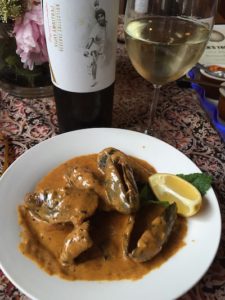Grover Zampa Indian Winery Reinvents Itself
(Gerry Furth-Sides) It was one of those spring days in Los Angeles where nothing could go wrong. The Grover Zampa wine tasting for wine writers and influencers at India’s Tandoori Brentwood hosted by owner, Matin Shah, proved it. No elevator? Guests happily took the stairs. Can’t make it for lunch? Matin laid out an equally impressive spread for dinner and one wine writer and grape grower even drove in from Temecula.
(Barbara Hansen) The wine, a Grover red blend, was surprisingly good, not sourish, like most Indians wines I had tasted. Fast forward a bundle of years, and I am tasting a Grover red blend again, not from a paper bag but at a respectable Indian restaurant in Los Angeles.
Grover has changed a lot over the years. The company is now Grover Zampa, the result of a merger, and produces quality wines that sell for as little as $9. Already exporting internationally, Grover is entering the American market starting with eight states, including California.
CEO Sumedh Singh Mandla came from India for the Los Angeles tasting, held at India’s Tandoori in Brentwood. The food was Indian, but not because Indian wines can’t stand up to other cuisines.
“We usually do tastings with international food,” Mandla said. “but Indian food is getting more refined, not as spicy, less oily, and well plated. We want to be part of that movement.”
Wine-making in India started from scratch in the 1970s, despite the conviction that wines couldn’t be produced in a tropical climate. At that time, Kanwal Grover, an Indian businessman, visited wineries in France and fell in love with what he tasted. Today, Grover vineyards are planted with French clones on American rootstock, and Kanwal Grover is regarded as the father of Indian viticulture.
The earlier wine was fine. This one, the 2012 La Réserve Cabernet Sauvignon-Shiraz was so good I would buy it by the case once it reaches Los Angeles.
The wines poured in Los Angeles were from vineyards in the Nandi Hills near Bangalore, one of three areas where the company has planted grapes, and the one that gives the best results.
In the 1990s, renowned French enologist Michel Rolland came on board as a consultant. More recently, Grover added star power by connecting with Vijay Amritraj, India’s most famous tennis player.
The two Vijay Amritraj wines are a Reserve Collection White (top right), which is a Viognier that is barrel fermented and aged on lees, and the Vijay Amritraj Reserve Collection Red (above), which blends Cabernet Sauvignon, Shiraz and Viognier. Amritraj is on the labels as he appeared in his heyday (above and at the top).
And here he is today, a surprise guest at the tasting.
The Amritraj white was paired with steamed mussels in a creamy curry-accented sauce and Chicken tikka masala (below).
Lamb seekh kebab and tandoor paneer went with La Réserve and the Vijay Amritraj red.
The other four wines were from the Art Collection, so named because each label features the work of an Indian artist, Paresh Maity, known for his tightly cropped faces.
The first wine poured was the 2013 Grover Art Collection Rosé (above), a dry, intense wine that is 100% Shiraz. Its deep salmony color resulted from skin contact with the grapes.
Paired with the rosé were potato pakoras with chickpea flour batter and spring rolls filled with noodles and vegetables.
The other Art Collection wines poured were a Sauvignon Blanc, made in the Loire style, and a Cabernet Shiraz, which was accompanied by fish or chicken tandoori.
Grover is experimenting with additional varietals. Tempranillo is giving good results, Mandla said. Others with potential are Cabernet Franc and Malbec. Merlot is less promising so far.
Syrah has done “wonderfully well,” and Mandla recommends it with Indian food, as well as Viognier. Missing from the line are Pinot Noir and Chardonnay. “The climate is not cool enough for them,” Mandla said.
Grapes are hand harvested and picked toward the evening when the temperature is lower. White wine grapes go to a cold room to relax before the wine-making process begins. The vines are young, averaging 8 to 10 years, with 15-year-old vines producing the grapes for La Réserve. Tonnage is kept low.
Grover produces 33 wines, seven of them chosen for the United States.”The trend [wine-drinking] has not really picked up in India,” Mandla said. There, spirits are more popular.
“Given the climate, rosé is good for India,” he said. The Art Collection rosé poured that day (at the right) was complex and assertive enough to be good anywhere, in my opinion.








 Gerry Furth-Sides
Gerry Furth-Sides  Barbara Hansen
Barbara Hansen  Chef-owner Alain Cohen
Chef-owner Alain Cohen  Roberta Deen
Roberta Deen  Jose Martinez
Jose Martinez  Nivedita Basu
Nivedita Basu